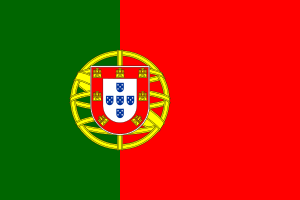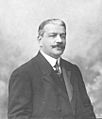Flag of Portugal facts for kids
The flag of Portugal (in Portuguese: Bandeira de Portugal) is the official national flag of the Portuguese Republic. It has two main colors, green and red, placed vertically. In the middle, right where the green and red meet, you'll see the smaller coat of arms of Portugal. This flag is a very important symbol for the country and its people.
Contents
What the Flag Looks Like
The Portuguese flag is divided into two parts. The green part is on the left, and the red part is on the right. The green section is smaller, taking up about two-fifths of the flag's length. The red section is larger, taking up the remaining three-fifths.
The Symbols on the Flag
The most important part of the flag is the national coat of arms, which sits in the center. This coat of arms is made up of two main symbols: an Armillary sphere and a shield.
The Armillary Sphere
The armillary sphere is a golden globe-like instrument. It has been a symbol of Portugal since the time of King Manuel I (who ruled from 1495 to 1521). This sphere represents Portugal's great history of exploration and discovery. Portuguese sailors, like Vasco da Gama, used tools similar to this to navigate the oceans and discover new lands. It reminds everyone of Portugal's important role in connecting different parts of the world.
The Portuguese Shield
In front of the armillary sphere is a white shield with five smaller blue shields on it. Each of these blue shields has five white dots, which look like coins. These five blue shields represent the five Moorish kings defeated by Portugal's first king, Afonso Henriques, in the Battle of Ourique in 1139. The five white dots on each blue shield are said to represent the five wounds of Christ.
Around the white shield, there is a red border with seven golden castles. These castles represent the victories of the Portuguese over their enemies and the territories they conquered. They also symbolize the seven castles that Afonso III captured from the Moors in 1249.
The Meaning of the Colors
The green and red colors of the flag also have special meanings.
Green
The green color on the flag stands for hope. It also represents the great discoveries made by Portuguese explorers. It symbolizes the future and the country's growth.
Red
The red color represents the courage and sacrifice of the Portuguese people. It honors those who fought for the nation and its freedom. It also symbolizes the revolution that led to the creation of the Portuguese Republic.
History of the Flag
The current design of the Portuguese flag was officially adopted on June 30, 1911. It was created after the revolution of October 5, 1910, which ended the monarchy and established the Portuguese Republic.
Before 1910, Portugal had different flags under its kings. The new republican government wanted a flag that would represent the new era and the values of the republic. A special committee was formed to design the new flag. This committee included important people like the painter Columbano Bordalo Pinheiro, the writer João Chagas, and the military leader Abel Botelho. They worked together to create the flag we see today, choosing symbols and colors that would represent Portugal's history, discoveries, and new republican ideals.
Images for kids
-
The new national flag is flown for the first time on the Monument to the Restorers in Lisbon, on December 1, 1910
-
The Armillary sphere has been a symbol of Portugal since the reign of King Manuel I.
-
O Milagre de Ourique (The Miracle of Ourique), by Domingos Sequeira (1763)
-
Flag hoisted at the Portuguese Parliament, in Lisbon
-
Flag hoisted at the Castle of São Jorge
-
A Portuguese tri-service color guard leads a detachment of marines, carrying the national colors during the 2007 Bastille Day Military Parade in Paris
See also
 In Spanish: Bandera de Portugal para niños
In Spanish: Bandera de Portugal para niños










